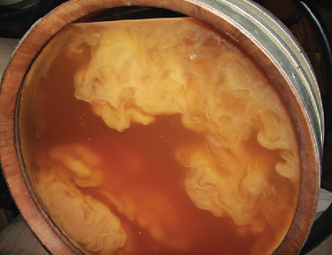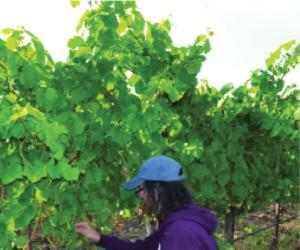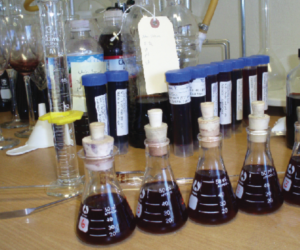 You want to add extra body and mouthfeel to your wines, or perhaps enhance those buttery or yeasty aromas and flavors in your barrel-fermented Chardonnay? Or maybe even round out those sharp tannins in young reds? Then you may want to consider lees stirring, or what the French call bâtonnage, the technique of stirring dead wine yeast cells with a “stick.”
You want to add extra body and mouthfeel to your wines, or perhaps enhance those buttery or yeasty aromas and flavors in your barrel-fermented Chardonnay? Or maybe even round out those sharp tannins in young reds? Then you may want to consider lees stirring, or what the French call bâtonnage, the technique of stirring dead wine yeast cells with a “stick.”
Lees stirring is commonly practiced in making rich, full-bodied, oak barrel-fermented whites, particularly Chard-onnay, as well as in sur-lie-style Melon de Bourgogne-based wines of Muscadet de Sèvre et Maine in the Loire Valley; in reds, it can be used to soften tannins and stabilize color. Lees stirring also improves colloidal and cold stability, thereby reducing the risk of hazing and tartaric salt crystallization. It can also be used to enhance lactic acid bacteria growth where malolactic fermentation (MLF) is desired. What’s not to like about lees stirring?
But the technique can prove disappointing and even disastrous if not performed properly and in a timely fashion.
Here we will look at the underlying physical chemistry and biochemistry of Saccharomyces cerevisiae yeast cells and the chemistry of lees stirring, and techniques to make superb wines and avoid pitfalls. Understanding the difference between gross lees and fine lees is critical in the application of lees stirring techniques, and in winemaking in general.
Yeast autolysis
At the end of alcoholic fermentation — once yeast cells complete their metabolic cycle, run out of nutrients and die, dead yeast cells, or lees, form a sediment layer at the bottom of the fermentation vessel. If left to interact with the wine, the yeasts’ own digestive enzymes will break the dead yeast cells down, in what is referred to as yeast autolysis. This causes the degradation of cell macromolecules and release of breakdown by-products into the wine. The most important by-products in the context of lees stirring include mannoproteins, glucans (more specifically, ββ-glucans, but that’s not really relevant for our purpose here), and chitin.
Mannoproteins are complex proteins consisting mainly of mannose sugar groups, but they may also contain a few glucose groups. Unlike other haze-forming proteins found in grape must and wine, mannoproteins actually enhance protein and tartrate stabilization. Exogenous mannoproteins are also available for use as yeast nutrient additives.
β-glucans are long polysaccharide chains consisting of glucose groups only. Cellulose, the major structural compound of wood and plants, is an example of a glucan. Chitin is also a long-chain polysaccharide and a major structural component of the shells of crustaceans. Chitin is used to manufacture chitosan, a common wine fining agent.
β-glucans are highly insoluble and can therefore cause clarification problems, as they can be particularly difficult to remove. They are not easily fined by fining agents nor do they flocculate easily, so they tend to clog up filter pads, particularly at cellar or warmer temperatures. Exogenous ββ-glucanase and glucosidase enzymes can be used to hydrolyze ββ-glucans into their glucose monomers to alleviate such processing problems.
In terms of aromas and flavors, yeast autolysis imparts yeasty notes, nuances of sourdough, baguette, mushroom or truffle. Yeast autolysis is the under-lying reaction so critical in Champagne and other traditional-method sparkling wine production where the wines are characteristically “yeasty.”
Gross lees vs. fine lees
The quality and desirability of lees depend on the size of the lees, usually divided into gross and fine lees — lees stirring involves fine lees only.
Gross lees are not desirable and must be eliminated quickly as they can contribute to the production of volatile sulfur compounds (VSCs), namely hydrogen sulfide (H2S), which can impart an unpleasant smell of rotten eggs. These lees also contain a myriad of other heavy solids such as pulp and grape skin fragments that may contain sulfur from vineyard spraying and exacerbate VSC production. H2S can form in as little as a week, or even less depending on various factors such as volume of gross lees, amount of sulfur on grapes, extent of maceration, and fermentation temperature.
Gross lees are defined as being greater than 100μμm (micrometers) in size (many times larger than a single S. cerevisiae cell, which is typically 5-10 μm) and which sediment within the first 24 hours after processing (e.g. racking). Just to put this into perspective, a coarse filter pad (e.g. #1) is typically rated 5-8 μm.
At the end of fermentation is when wine is at its highest risk of developing VSCs, hence why it is important to aerate gross lees-laden red wines, particularly where extended post-ferment maceration is practiced. You have to be particularly vigilant in racking wine off the gross lees in a timely fashion as the wine develops a VSC gradient from the bottom of the vessel towards the top, so you may not detect H2S if you take a wine sample from the top of the vessel to smell. Always try to take a sample from as close to the bottom of the vessel as possible. A professional wine thief is ideal for carboys.
Gross lees continue sedimenting well after the end of fermentation and right through into the maturation phase, however, the much smaller volumes are of no concern as these are progressively removed with every racking.
Fine lees are “purer” as they are to a large extent free of larger particles and compounds that may cause VSCs. Fine lees range between one and several tens of μm in size and which remain suspended after 24 hours of processing. The small amounts of mannoproteins and ββ-glucans released when the lees are stirred allow for graceful interactions in wine compounds to add body and a creamier mouthfeel.
In traditional-method sparkling wine production, the lees are not removed until the disgorgement step, yet no VSCs are produced, at least not in typical maturation periods, some of which can last many years. Yeast autolysis here produces fine lees and the hostile high-pressure environment slows down all those biochemical and chemical reactions.
Stirring the lees
An effective lees stirring regimen depends on the volume of lees created and left in contact with the wine, the length of contact (i.e. aging), and the frequency of stirring.
As a first step, stir the entire wine volume in the vessel before the gross-lees racking operation to get all the lees back into suspension. After 4-8 hours, the gross lees will have precipitated while the fine lees remain in suspension, and then rack the wine. The gross lees precipitation duration will depend on the volume and shape of the vessel.
Following the gross lees racking, stir the fine lees using a 2-paddle stirring rod or a traditional bâtonnage cane once a day initially and then progressively reduce to two or three times per week, then to once a week. The stirring period can last several weeks or months during the aging period to a maximum of 12 months until you achieve your desired style. Similarly, adjust the stirring frequency based on your desired style—this will come with experience. But remember: you must stir the wine and get all the lees into suspension, otherwise, it is still at risk of developing VSCs. Stir gently to minimize oxygen uptake and foaming (remember that there is still considerable carbon dioxide in wine at the end of alcoholic fermentation).
At the end of the lees stirring period, let the wine settle for a week or more (depending on vessel volume and shape), rack, fine and/or filter. Filtration should be performed progressively down to a fine grade, i.e. at least 0.5 μm. This means that the fine lees must be given a chance to precipitate completely (naturally or by using a fining agent) before filtering.
Other benefits
Though only a speculation at this stage of research, it is believed that aging wine on the lees can help maintain the concentration of glutathione, or GSH, a naturally occurring compound in grapes and possessing strong antioxidant owing to its very high redox power. GSH is particularly important during crushing and pre-fermentation processing where it reverts brown-colored oxidized phenolics, or quinones, back to their colorless forms. As yeast can contain up to 1% (dry weight) GSH, some of which is utilized during fermentation, post-fermentation GSH concentration can increase or decrease depending on the yeast strain, the extent of yeast autolysis, and the grape varietal at hand.
Aging on the lees in conjunction with exogenous glucanase enzymes and a proper stirring regimen can be used to reduce the astringency imparted by harsh tannins. Mannoprotein–tannin interactions can then impact red wine color and stability owing to the reduced tannin (proanthocyanin) content available to interact with anthocyanins. But this may also mean softer tannins, particularly in barrel-aged wines where yeast mannoproteins bind with oak tannins (ellagitannins).
But unlike proteins, mannoproteins do not cause protein instabilities and haze; in fact, mannoproteins act as protective colloids against haze formation. It has been shown that mannoproteins from aging on the lees have much greater ability to reduce turbidity than a simple bentonite treatment following alcoholic fermentation, and to have similar effects as adding mannoproteins following alcoholic fermentation with both requiring much less bentonite. Bentonite should only be added following the sur-lie treatment to avoid stirring it back into suspension at every stir.
A novel application
Quite interestingly, French enologists Valérie Lavigne-Cruège and Denis Dubourdieu have proposed a very effective method to deal with post-alcoholic fermentation VSCs, namely, H2S, methanethiol and ethanethiol in white wines aging on the lees in oak barrels. Methanethiol can impart unpleasant and repulsive smells of putrid feces, cooked or rotten cabbage and burnt rubber while ethanethiol is responsible for onion, natural gas, burnt match, and skunky smells — certainly not good compounds to have in your wine.
Lavigne-Cruège and Dubourdieu demonstrated that a simple racking and aeration is not sufficient to eliminate such unpleasant odors. Rather, they propose a racking with aeration and a temporary removal of the lees. The lees left behind in the barrel are stirred frequently over a 48-hour period and then re-introduced into the wine.
The enologists demonstrated a marked decrease in H2S, though comparable to a double racking with aeration treatment, but a complete elimination of methanethiol and ethanethiol. This suggests that mannoproteins are able to absorb certain VSCs. What was also interesting is that the lees stopped producing VSCs once re-introduced into the wine.
And for the health conscious
Stirring the lees has been shown to cause nearly the entire vitamin content to be re-introduced into the wine. There’s something to drink to. Cheers!







